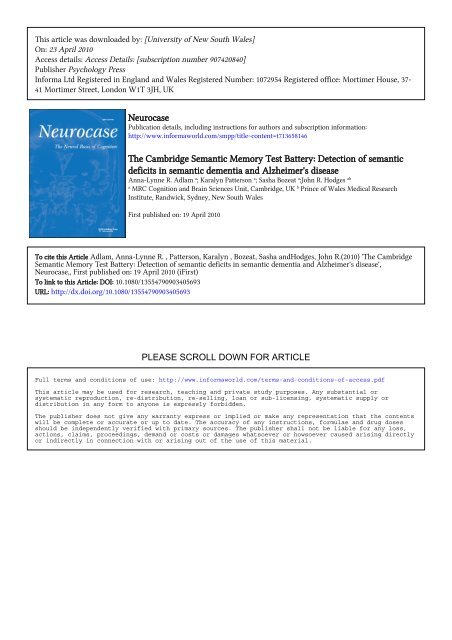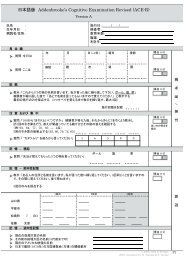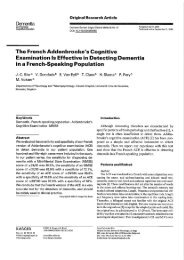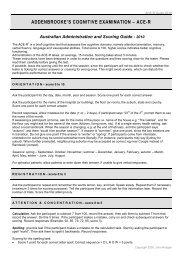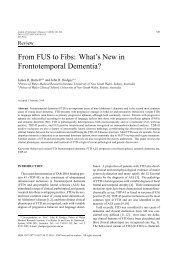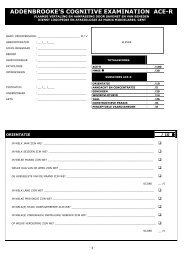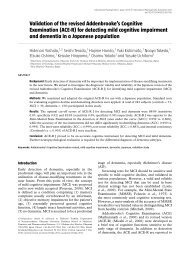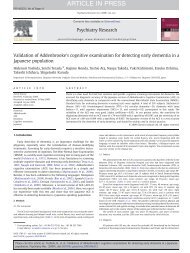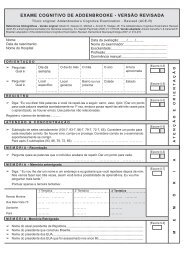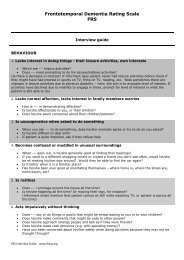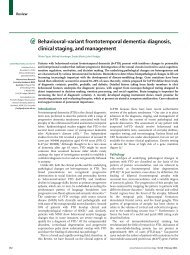Neurocase The Cambridge Semantic Memory Test Battery ...
Neurocase The Cambridge Semantic Memory Test Battery ...
Neurocase The Cambridge Semantic Memory Test Battery ...
You also want an ePaper? Increase the reach of your titles
YUMPU automatically turns print PDFs into web optimized ePapers that Google loves.
This article was downloaded by: [University of New South Wales]<br />
On: 23 April 2010<br />
Access details: Access Details: [subscription number 907420840]<br />
Publisher Psychology Press<br />
Informa Ltd Registered in England and Wales Registered Number: 1072954 Registered office: Mortimer House, 37-<br />
41 Mortimer Street, London W1T 3JH, UK<br />
<strong>Neurocase</strong><br />
Publication details, including instructions for authors and subscription information:<br />
http://www.informaworld.com/smpp/title~content=t713658146<br />
<strong>The</strong> <strong>Cambridge</strong> <strong>Semantic</strong> <strong>Memory</strong> <strong>Test</strong> <strong>Battery</strong>: Detection of semantic<br />
deficits in semantic dementia and Alzheimer's disease<br />
Anna-Lynne R. Adlam a ; Karalyn Patterson a ; Sasha Bozeat a ;John R. Hodges ab<br />
a MRC Cognition and Brain Sciences Unit, <strong>Cambridge</strong>, UK b Prince of Wales Medical Research<br />
Institute, Randwick, Sydney, New South Wales<br />
First published on: 19 April 2010<br />
To cite this Article Adlam, Anna-Lynne R. , Patterson, Karalyn , Bozeat, Sasha andHodges, John R.(2010) '<strong>The</strong> <strong>Cambridge</strong><br />
<strong>Semantic</strong> <strong>Memory</strong> <strong>Test</strong> <strong>Battery</strong>: Detection of semantic deficits in semantic dementia and Alzheimer's disease',<br />
<strong>Neurocase</strong>,, First published on: 19 April 2010 (iFirst)<br />
To link to this Article: DOI: 10.1080/13554790903405693<br />
URL: http://dx.doi.org/10.1080/13554790903405693<br />
PLEASE SCROLL DOWN FOR ARTICLE<br />
Full terms and conditions of use: http://www.informaworld.com/terms-and-conditions-of-access.pdf<br />
This article may be used for research, teaching and private study purposes. Any substantial or<br />
systematic reproduction, re-distribution, re-selling, loan or sub-licensing, systematic supply or<br />
distribution in any form to anyone is expressly forbidden.<br />
<strong>The</strong> publisher does not give any warranty express or implied or make any representation that the contents<br />
will be complete or accurate or up to date. <strong>The</strong> accuracy of any instructions, formulae and drug doses<br />
should be independently verified with primary sources. <strong>The</strong> publisher shall not be liable for any loss,<br />
actions, claims, proceedings, demand or costs or damages whatsoever or howsoever caused arising directly<br />
or indirectly in connection with or arising out of the use of this material.
Downloaded By: [University of New South Wales] At: 01:21 23 April 2010<br />
NEUROCASE<br />
2010, iFirst, 1–15<br />
= NNCS<br />
<strong>The</strong> <strong>Cambridge</strong> <strong>Semantic</strong> <strong>Memory</strong> <strong>Test</strong> <strong>Battery</strong>:<br />
Detection of semantic deficits in semantic dementia<br />
and Alzheimer’s disease<br />
<strong>Cambridge</strong> <strong>Semantic</strong> <strong>Memory</strong> <strong>Test</strong> <strong>Battery</strong><br />
Anna-Lynne R. Adlam, 1 Karalyn Patterson, 1 Sasha Bozeat, 1<br />
and John R. Hodges 1,2<br />
1 MRC Cognition and Brain Sciences Unit, <strong>Cambridge</strong>, UK<br />
2 Prince of Wales Medical Research Institute, Randwick, Sydney, New South Wales<br />
<strong>The</strong> aims of this study were (a) to explore the utility of, and make more widely available, an updated and extended<br />
version of the <strong>Cambridge</strong> <strong>Semantic</strong> <strong>Memory</strong> test battery, and (b) to use this battery in conjunction with other tests<br />
to characterise the profile of several different forms of progressive cognitive impairment: semantic dementia (SD,<br />
n = 15), mild cognitive impairment (MCI, n = 7), established Alzheimer’s disease (AD) (n = 8), all in comparison<br />
to normal controls (n = 45). <strong>The</strong> semantic battery is useful in a variety of ways for exploring the nature of<br />
semantic deficits; on its own, however, it does not provide sensitive differentiation between patients with AD and<br />
SD. An assessment including measures of episodic memory and visuospatial abilities as well as the semantic battery<br />
is recommended for good characterisation of the cognitive profiles associated with SD and AD.<br />
Keywords: <strong>Memory</strong>; Neuropsychology; <strong>Memory</strong> disorders; Dementia; <strong>Semantic</strong> Dementia; Alzheimer’s disease.<br />
INTRODUCTION<br />
Previously we have reported a battery of neuropsychological<br />
tests used within our clinic (e.g., Hodges,<br />
Salmon, & Butters, 1990; Hodges, Patterson,<br />
Oxbury, & Funnell, 1992a; Hodges & Patterson,<br />
1995; Hodges et al., 1999) to assess semantic memory,<br />
episodic memory and other aspects of cognitive<br />
processing. Here, we describe the full battery of<br />
tests, including a newly devised measure of associative<br />
semantic memory (the Camel and Cactus<br />
<strong>Test</strong>), and compare the performance across different<br />
patient groups (<strong>Semantic</strong> Dementia, Mild Cognitive<br />
Impairment, and Alzheimer’s disease).<br />
<strong>The</strong> <strong>Cambridge</strong> <strong>Semantic</strong> <strong>Memory</strong> (CSM) test<br />
battery is a collection of tests that use the same set<br />
of stimulus items to assess semantic knowledge<br />
systematically across different input and output<br />
modalities. <strong>The</strong> original version consisted of 48<br />
items, half living and half manmade, which were<br />
not well matched for familiarity or age of acquisition,<br />
factors known to have a significant influence on<br />
performance (Barry & Ellis, 1997; Funnell, 1992;<br />
Stewart, Parkin, & Hunkin, 1992). <strong>The</strong> updated<br />
battery contains 64 items representing three subcategories<br />
of living things (animals, birds and fruit)<br />
and three sub-categories of artefacts (household<br />
items, tools and vehicles). It was not possible to create<br />
a single set of items matched across living and<br />
manmade categories for both concept familiarity<br />
and age of acquisition, so two stimulus subsets<br />
were assembled, each consisting of 16 living and 16<br />
We thank the participants and their families for their continued support with our research. This research was funded by the Medical<br />
Research Council (MRC).<br />
Address correspondence to Professor John R. Hodges, Prince of Wales Medical Research Institute, Randwick, Sydney, New South<br />
Wales, 2031, Australia. (E-mail: j.hodges@powmri.edu.au).<br />
© 2010 Psychology Press, an imprint of the Taylor & Francis Group, an Informa business<br />
http://www.psypress.com/neurocase DOI: 10.1080/13554790903405693
Downloaded By: [University of New South Wales] At: 01:21 23 April 2010<br />
2 ADLAM ET AL.<br />
non-living concepts (see Appendix A). One of these<br />
subsets was matched across the two domains for<br />
concept familiarity and the other for age of<br />
acquisition (see Garrard et al., 2001; Morrison,<br />
Chappell, & Ellis, 1997; Snodgrass & Vanderwart,<br />
1980). <strong>The</strong> semantic memory tests on these 64<br />
items and their sub-categories include: category<br />
fluency; picture naming (to the line drawings);<br />
word comprehension (word–picture matching);<br />
sorting by category at three levels (superordinate,<br />
basic and subordinate) for both pictures and<br />
words; and a more recently devised measure of<br />
semantic association, the Camel and Cactus <strong>Test</strong><br />
(CCT, Bozeat, Lambon Ralph, Patterson, Garrard,<br />
& Hodges, 2000). <strong>The</strong> CCT was designed along the<br />
principles of the Pyramids and Palm Trees test<br />
(PPT, Howard & Patterson 1992), and the PPT –<br />
despite not being based on the same items/subcategories<br />
that are stimuli for all of the other<br />
semantic tests – was also included for comparison.<br />
Our earlier studies (Hodges & Patterson, 1995;<br />
Hodges et al., 1999), using the original semantic<br />
memory test battery, reliably identified patients<br />
with advanced stage semantic dementia (SD). We<br />
have since been able to identify patients earlier in<br />
the course of the disease who show subtle, but definite,<br />
semantic deficits on our experimental measures.<br />
<strong>The</strong>se patients have bilateral anterior temporal<br />
lobe atrophy, usually more notable on the left, and<br />
eventually progress to the typical profile as<br />
described in our earlier work (e.g., Bozeat et al.,<br />
2000; Bozeat, Lambon Ralph, Patterson, &<br />
Hodges, 2002; Hodges, Bozeat, Lambon Ralph,<br />
Patterson, & Spatt, 2000b; Lambon Ralph,<br />
McClelland, Patterson, Galton, & Hodges, 2001a;<br />
Rogers, Lambon Ralph, Hodges, & Patterson,<br />
2003). <strong>The</strong>se milder patients, however, do not<br />
always show deficits on the Pyramids and Palm<br />
Trees test or the word–picture matching task (e.g.,<br />
Nestor, Fryer, & Hodges, 2006). It is in light of<br />
these findings that we devised a more difficult<br />
measure of semantic associative knowledge, the<br />
Camel and Cactus <strong>Test</strong>, which comprises the same<br />
64 items as presented for naming and word–picture<br />
matching (see Bozeat et al., 2000) and hence ‘inherits’<br />
the advantages of the basis for selection of those<br />
items (e.g., half living and half manmade, with<br />
familiarity and age-of-acquisition matching as<br />
described above). <strong>The</strong> test has two forms: in one,<br />
all items (targets and response choices) are presented<br />
as pictures; in the other form, all stimuli are<br />
words. Using a procedure similar to, but more taxing<br />
than, that in the PPT, here participants are<br />
required to choose the correct response from four<br />
same-category items (e.g., for the target camel, the<br />
four response choices are tree, sunflower, cactus<br />
(the correct response), and rose). <strong>The</strong> fact that<br />
chance level is therefore .25 (rather than .5 as in the<br />
PPT) should make this test more sensitive than its<br />
predecessor.<br />
An important feature of the CSM battery is that<br />
knowledge of all items is assessed in both verbal<br />
and non-verbal modalities of stimulus and/or<br />
response, enabling the clinician or researcher to<br />
detect differential impairments across these<br />
domains of input/output. It is, however, important<br />
to emphasise that a non-verbal > verbal pattern of<br />
performance does not necessarily equate to a<br />
modality-specific deficit. This pattern of performance<br />
is also to be expected from an amodal, central<br />
semantic deficit on the basis of differences in the<br />
way in which objects vs. words relate to meaning<br />
(see Benedet, Patterson, Gomez-Pastor, & Luisa<br />
Garcia de la Rocha, 2006; Bozeat et al., 2000;<br />
Lambon Ralph & Howard, 2000; Patterson &<br />
Hodges, 2000). <strong>The</strong> mapping between the visual<br />
appearance of an object (either the whole form or<br />
parts of it) and its meaning is always more coherent<br />
than is the case for words, whose surface forms<br />
have an arbitrary relationship to their meanings.<br />
We have previously published the performance of<br />
patients with Alzheimer’s disease (AD) on the original<br />
semantic memory battery (Hodges & Patterson,<br />
1995; Hodges, Salmon, & Butters, 1991; Hodges,<br />
Salmon, & Butters, 1992b; Hodges, Patterson,<br />
Graham, & Dawson, 1996; Lambon Ralph, Patterson,<br />
& Hodges, 1997) and some components of the<br />
new battery (Garrard, Lambon Ralph, Patterson,<br />
Pratt, & Hodges, 2005; Lambon Ralph et al., 2001b).<br />
Although the semantic memory impairment in AD is<br />
well documented (see for example Chertkow & Bub,<br />
1990; as well as publications from our group), much<br />
of this research has tended to focus on the underlying<br />
cause of the deficit (e.g., ‘access’ vs. ‘storage’) rather<br />
than the stage of the disease process at which the<br />
impairment becomes detectable. Mild Cognitive<br />
Impairment (MCI) may represent the preclinical<br />
stage of early AD (Grundman et al., 2004; Petersen<br />
et al., 2001). Recent studies, however, highlight the<br />
heterogeneity in this patient population (e.g., Albert,<br />
Moss, Tanzi, & Jones, 2001; Blackwell et al., 2004;<br />
Chen et al., 2000; Chetelat et al., 2003; De Jager,<br />
Hogervorst, Combrinck, & Budge, 2003; Jack et al.,<br />
1999; Petersen et al., 1999), indicating that not all<br />
cases with MCI will go on to develop full-blown AD.<br />
It is of interest, therefore, to investigate whether
Downloaded By: [University of New South Wales] At: 01:21 23 April 2010<br />
patients with so-called MCI also have semantic memory<br />
deficits (e.g., Bennett et al., 2002; Bozoki,<br />
Giordani, Heidebrink, Berent, & Foster, 2001; De<br />
Jager et al., 2003; De Jager & Budge, 2005; Dudas,<br />
Clague, Thompson, Graham, & Hodges, 2005;<br />
Estévez-González et al., 2004; Lambon Ralph et al.,<br />
2003; Thompson, Graham, Patterson, Sahakian, &<br />
Hodges, 2002), when assessed on the updated CSM<br />
test battery.<br />
It is, therefore, timely to determine whether the<br />
updated CSM test battery is sensitive to semantic<br />
deficits in MCI and AD, and to compare directly<br />
the performance of patients with MCI, AD and<br />
SD. This is a valuable goal for a variety of reasons,<br />
including the differentiation of MCI and AD from<br />
other forms of dementia early in the course of the<br />
disease. Such differential diagnoses determine<br />
appropriate information to be given to patients<br />
and their families regarding the nature and likely<br />
time-course of progression, possible genetic implications,<br />
etc; and as effective disease modifying<br />
interventions gradually become available, such<br />
early diagnosis will of course be of even greater<br />
significance.<br />
In addition to the semantic memory measures, a<br />
general neuropsychological battery of tests was<br />
included. <strong>The</strong>se measures include: short-term<br />
memory (digit span), episodic memory (story and<br />
design recall), executive function (letter fluency),<br />
and visuospatial perception. Compatible with a<br />
diagnosis of MCI or AD, previous studies have<br />
revealed episodic memory impairments in patients<br />
with MCI and AD (e.g., Dudas et al., 2005;<br />
Hodges et al., 1990, 1999; Perri, Carlesimo, Serra,<br />
& Caltagirone, 2005; Perry, Watson, & Hodges,<br />
2000; Welsh, Butters, Hughes, Mohs, & Heyman,<br />
1991, 1992), while patients with SD perform well<br />
on at least some measures of non-verbal episodic<br />
recall (e.g., Scahill, Hodges, & Graham, 2005).<br />
Furthermore, patients with AD, but not SD, have<br />
been shown to have deficits on measures of<br />
MCI<br />
(range)<br />
CAMBRIDGE SEMANTIC MEMORY TEST BATTERY 3<br />
attention (e.g., Amieva, Phillips, Della Sala, &<br />
Henry, 2004; Perry & Hodges, 1999; Pignatti<br />
et al., 2005), visuospatial perception (e.g., Caine &<br />
Hodges, 2001; Perry et al., 2000; Ringman, 2005), and<br />
executive function (e.g., Perry & Hodges, 1999), early<br />
in the course of the disease. <strong>The</strong>refore, in addition to<br />
exploring the nature of semantic memory in these<br />
patient groups, this study also aimed to characterise<br />
performance on more general neuropsychological<br />
measures.<br />
In summary, the two main aims of this study<br />
were: (i), to make more fully available the updated<br />
<strong>Cambridge</strong> <strong>Semantic</strong> <strong>Memory</strong> (CSM) test battery,<br />
including a recently devised test intended to be sensitive<br />
to mild semantic impairment (the CCT); and<br />
(ii), to characterise and compare the neuropsychological<br />
profiles of different patient groups (i.e.,<br />
MCI, AD, and SD).<br />
Participants<br />
TABLE 1<br />
<strong>The</strong> mean age at test and years of education<br />
AD<br />
(range)<br />
SD<br />
(range)<br />
METHODS<br />
A total of 75 subjects took part in this study: 7<br />
patients with a clinical diagnosis of amnestic MCI,<br />
8 patients who had a fairly typical AD profile, 15<br />
patients who fitted the criteria for SD, and 45 control<br />
subjects.<br />
Controls were selected from the Medical<br />
Research Council Cognition and Brain Sciences<br />
Unit’s participant panel. Twenty controls were<br />
administered the full semantic battery except for<br />
the Camel and Cactus <strong>Test</strong> (CCT) which was not<br />
yet developed at the time of this original data collection.<br />
An additional 25 controls were subsequently<br />
tested on the CCT.<br />
<strong>The</strong> mean age range and years of education of<br />
the patient groups and the controls are shown in<br />
Table 1. Analysis revealed that the SD group was significantly<br />
younger than the AD group (t(21) = 3.33,<br />
Control<br />
(range)<br />
Control CCTpic<br />
(range)<br />
Control CCTword<br />
(range)<br />
Sex (F/M) 2/5 4/4 5/10 10/10 8/8 10/4<br />
Years of education 10.7 (9–13) 10.1 (9–12) 11.07 (8–13) 11.0 (9–13) 12.7 (10–15) 12.0 (10–14)<br />
Age at test (years) 65.4 (51–78) 72.4 (68–82) 61.4 (42–78) 68.1 (54–78) 63.6 (55–79) 61.0 (55–68)<br />
<strong>The</strong> range is shown for each score. MCI represents mild cognitive impairment; AD represents Alzheimer’s disease; SD represents<br />
semantic dementia; CCT represents Camel and Cactus <strong>Test</strong>.
Downloaded By: [University of New South Wales] At: 01:21 23 April 2010<br />
4 ADLAM ET AL.<br />
p = .003). In addition, the control group who completed<br />
the picture version of the CCT had significantly<br />
more years of education relative to each of<br />
the patient groups (p < .0005–.007) and were significantly<br />
younger than the AD group (t(22) =<br />
2.82, p = .01). <strong>The</strong> control group who completed<br />
the word version of this test had significantly more<br />
years of education than the MCI (t(19) = 2.16, p =<br />
.04) and AD (t(20) = 3.79, p = .001) groups, and<br />
were significantly younger than the AD group<br />
(t(20) = 5.77, p < .0005). In order to account for<br />
the potential impact of these differences in age at<br />
test and years of education, these variables were<br />
entered into analyses of covariance (see details in<br />
the Results section).<br />
<strong>The</strong> patients presented to the <strong>Memory</strong> Clinic at<br />
Addenbrooke’s Hospital, <strong>Cambridge</strong> where they<br />
were seen by a senior neurologist (JRH), a psychiatrist<br />
and a clinical neuropsychologist. In addition<br />
to a clinical assessment, all patients were given a<br />
number of standard psychiatric rating scales to<br />
exclude major psychiatric disorders such as depression<br />
or schizophrenia.<br />
Patients with amnestic MCI (Grundman et al.,<br />
2004; Petersen et al., 2001) presented with complaints<br />
of poor memory with preservation of activities of<br />
daily life, both substantiated by a spouse/family member.<br />
Neuropsychological assessment (see Background<br />
Neuropsychology, Table 2) revealed impairment<br />
(≥2 SDs below normal) on at least one test of episodic<br />
memory but normal performance on a range<br />
of other routine tests administered in the memory<br />
clinic (Hodges et al., 2000a) and a score on the<br />
Mini-Mental State Examination (MMSE) of >24.<br />
Patients with AD fulfilled NINCDS-ADRDA criteria<br />
(McKhann et al., 1984) and had evidence of<br />
impaired memory (see Table 2) plus deficits in at least<br />
one other cognitive domain, MMSE scores
Downloaded By: [University of New South Wales] At: 01:21 23 April 2010<br />
All subjects gave informed consent to participate<br />
in the study, according to the Declaration of Helskini<br />
(BMJ 1991; 302: 1194), which was approved by the<br />
Ethical Committee of Addenbrooke’s Hospital,<br />
<strong>Cambridge</strong>.<br />
Background neuropsychology<br />
<strong>The</strong> following battery of neuropsychological tests<br />
was administered: the Mini-Mental State Examination<br />
(Folstein, Folstein, & McHugh, 1975); the<br />
digit span subtests (both forwards and backwards)<br />
of the Wechsler <strong>Memory</strong> Scale-Revised (WMS-R,<br />
Wechsler, 1987); verbal fluency for the letters F, A,<br />
S; copy and delayed recall of the Rey Complex Figure<br />
(Rey, 1941); various subtests from the Visual<br />
Object and Space Perception battery (Warrington<br />
& James, 1991); and the logical memory subtest of<br />
the Wechsler <strong>Memory</strong> Scale Revised (WMS-R,<br />
Wechsler, 1987).<br />
<strong>Cambridge</strong> <strong>Semantic</strong> <strong>Memory</strong> <strong>Test</strong><br />
<strong>Battery</strong> (CSM)<br />
<strong>The</strong> following battery of tests was administered to<br />
investigate semantic memory performance. Each test<br />
(except for the Pyramids and Palm Trees test) used the<br />
same 64 items from the same six categories (animals,<br />
birds, fruits; household items, tools, and vehicles).<br />
Category fluency<br />
In this test, the subject is asked to produce as<br />
many exemplars as possible in one minute, for each<br />
of the six categories.<br />
Naming<br />
<strong>The</strong> subject is shown a line drawing of each of<br />
the 64 items and asked to produce its name.<br />
Word-to-Picture matching<br />
Subjects are presented with 64 picture arrays,<br />
one for each item, with each array consisting of 10<br />
items from the same category (e.g., birds); the task<br />
is to point to the item named by the examiner.<br />
Across the arrays within one category, the target<br />
and foil items move around to different positions;<br />
furthermore, two of the 10 items in each category<br />
are never targets. <strong>The</strong>se design factors prevent participants<br />
who remember their own previous choices<br />
within a category from working out subsequent<br />
CAMBRIDGE SEMANTIC MEMORY TEST BATTERY 5<br />
correct responses by a simple process of elimination.<br />
<strong>The</strong> test sequence is consistent across subjects<br />
and is arranged so that each item is followed by an<br />
item from a different category.<br />
Picture sorting<br />
In this test, the subject is asked to sort pictures<br />
of the 64 items at a superordinate level, or Level 1<br />
(living vs. manmade, maximum score 64), then into<br />
basic categories, or Level 2 (for living things: animals<br />
vs. birds vs. fruit; for artefacts: household<br />
objects vs. tools vs. vehicles, maximum score 64)<br />
and finally at subordinate level or Level 3 (for living<br />
things: native vs. foreign, larger than a man vs.<br />
smaller than a man, meat-eating vs. non-meat eating;<br />
for artefacts: made mainly of metal vs. not<br />
made mainly of metal, wooden parts vs. no wooden<br />
parts, will fit in your pocket vs. will not fit in your<br />
pocket, Level 3, maximum score 144).<br />
Word sorting<br />
<strong>The</strong> procedure is exactly same as above except<br />
that the participants sort cards with the written<br />
names of the items rather than pictures of them.<br />
<strong>The</strong> Pyramids and Palm Trees <strong>Test</strong><br />
(Howard & Patterson, 1992)<br />
Subjects are asked to choose one of two items<br />
that is most closely associated with the target (e.g.,<br />
for the target pyramid, the choice is between palm<br />
tree (the correct response choice) and pine tree).<br />
<strong>The</strong> stimuli are presented as either pictures or written<br />
words.<br />
<strong>The</strong> Camel and Cactus <strong>Test</strong> (Bozeat et al.,<br />
2000)<br />
This is a test of semantic association based on<br />
the principle of the Pyramids and Palm Trees test<br />
(Howard & Patterson, 1992). Subjects are asked to<br />
choose the correct one of four response-choice pictures<br />
or words that has an associative relationship<br />
with the target (n = 64). For example, in one of the<br />
trials the subject was asked to match the target<br />
camel to one of four types of vegetation: tree,<br />
sunflower, cactus (the correct response), or rose.<br />
Statistical analysis<br />
<strong>The</strong> data were analysed using separate analyses of<br />
variance. Age at test and amount of education were
Downloaded By: [University of New South Wales] At: 01:21 23 April 2010<br />
6 ADLAM ET AL.<br />
included as covariates in the analysis comparing the<br />
performance of the patients and controls on the<br />
Camel and Cactus <strong>Test</strong>. Significant main effects<br />
and simple main effects, following significant interactions,<br />
were analysed using one-way ANOVAs<br />
with corrections for multiple comparisons (Bonferroni<br />
correction). Details of the analysis are<br />
reported in Table 3.<br />
RESULTS<br />
<strong>Cambridge</strong> <strong>Semantic</strong> <strong>Memory</strong> <strong>Battery</strong><br />
Category Fluency <strong>Test</strong><br />
Separate one-way ANOVAs (see Table 3 and<br />
Figure 1) revealed that the control group generated<br />
significantly more items than the patient<br />
groups on both the living and manmade categories.<br />
<strong>The</strong> MCI patient group performed better<br />
than the SD group on the living and manmade<br />
categories, but only better than the AD group on<br />
the manmade category (however, these group differences<br />
did not survive Bonferroni correction,<br />
p < .008). <strong>The</strong> AD patient group’s performance<br />
did not significantly differ from that of the SD<br />
group on either category.<br />
Naming and word-to-picture matching<br />
Separate one-way ANOVAs (see Table 3 and<br />
Figure 2) revealed that the SD group was significantly<br />
impaired relative to both controls and the<br />
MCI patient group on the naming task (no other<br />
group differences survived Bonferroni correction,<br />
p < .008). In contrast, both the SD and MCI<br />
patient groups were significantly impaired relative<br />
to controls on the word–picture matching task,<br />
with the MCI and AD patient groups performing<br />
marginally better than the SD group.<br />
Sorting words and pictures<br />
A previous study of semantic memory in SD<br />
from our research group reported better performance<br />
on tasks involving pictures compared to those<br />
using words (Bozeat et al., 2000), and attributed<br />
these differences to the nature of mapping between<br />
input modality and semantic memory. As noted in<br />
the Introduction, word forms have a completely<br />
arbitrary relationship with meaning, whereas<br />
object structure as revealed in pictures has a degree<br />
of systematicity with conceptual knowledge about<br />
the object, and therefore a more coherent mapping<br />
between appearance and meaning (e.g., Benedet et al.,<br />
2006; Lambon Ralph & Howard, 2000; Patterson<br />
& Hodges, 2000).<br />
In order to investigate this issue in the current<br />
study, we analysed the category sorting data with a<br />
mixed-model ANOVA including a between-subjects<br />
factor of Group (MCI, AD, SD, control), a<br />
within-subjects factor of Modality (words, pictures)<br />
and a within-subjects factor of Level (level 1,<br />
level 2, level 3). Table 3 displays the results of this<br />
Total correct<br />
70.0<br />
60.0<br />
50.0<br />
40.0<br />
30.0<br />
20.0<br />
10.0<br />
0.0<br />
living<br />
manmade<br />
Control MCI AD SD<br />
Figure 1. <strong>The</strong> mean number of correct items generated on the<br />
category fluency test for living and nonliving categories for each<br />
group. Standard errors are shown for each group. MCI represents<br />
mild cognitive impairment; AD represents Alzheimer’s<br />
disease; SD represents semantic dementia.<br />
Total correct<br />
64.0<br />
56.0<br />
48.0<br />
40.0<br />
32.0<br />
24.0<br />
16.0<br />
8.0<br />
0.0<br />
naming<br />
word-picture matching<br />
Control MCI AD SD<br />
Figure 2. <strong>The</strong> mean number of correct items on the naming test<br />
and word picture matching tests (maximum = 64) for each<br />
group. Standard errors are shown for each group. MCI represents<br />
mild cognitive impairment; AD represents Alzheimer’s<br />
disease; SD represents semantic dementia.
Downloaded By: [University of New South Wales] At: 01:21 23 April 2010<br />
CAMBRIDGE SEMANTIC MEMORY TEST BATTERY 7<br />
TABLE 3<br />
Summary of the group statistical analyses for the <strong>Cambridge</strong> <strong>Semantic</strong> <strong>Memory</strong> <strong>Test</strong> <strong>Battery</strong>:<br />
Category fluency (living and manmade), and the 64-item task (naming and word–picture<br />
matching); Sorting task; Camel and Cactus <strong>Test</strong> (pictures and words), and Pyramids and Palm<br />
Trees test (pictures and words)<br />
F df p-value<br />
Category fluency<br />
Living 43.18 3, 46
Downloaded By: [University of New South Wales] At: 01:21 23 April 2010<br />
8 ADLAM ET AL.<br />
analysis, and Figure 3a–c present the results (%<br />
correct between 100% and chance) for each participant<br />
group, comparing pictures and words, at each<br />
of the three levels.<br />
Analysis revealed main effects of all three principal<br />
factors: Group, Modality (Pictures > Words)<br />
TABLE 3<br />
(Continued)<br />
F df p-value<br />
SD vs. Control 6.29 1, 30 .018<br />
AD vs. Control<br />
Level 2<br />
9.41 1, 25 .005<br />
MCI vs. AD 0.006 1, 12 .94<br />
MCI vs. SD 3.16 1, 17 .09<br />
MCI vs. Control 0.001 1, 25 .98<br />
SD vs. AD 3.35 1, 17 .09<br />
SD vs. Control 9.37 1, 30 .005<br />
AD vs. Control<br />
Level 3<br />
0.007 1, 25 .93<br />
MCI vs. AD 2.68 1, 12 .13<br />
MCI vs. SD 4.99 1, 17 .04<br />
MCI vs. Control 0.27 1, 25 .61<br />
SD vs. AD 1.70 1, 17 .21<br />
SD vs. Control 12.96 1, 30 .001<br />
AD vs. Control 5.99 1, 25 .02<br />
Modality × Level 0.92 1.76, 73.84 .39<br />
Group × Modality × Level<br />
Pyramids and Palm Trees<br />
0.97 5.27, 73.84 .44<br />
Pictures 3.15 2, 27 .06<br />
MCI vs. AD 0.83 1, 13 .38<br />
MCI vs. SD 5.35 1, 20 .03<br />
SD vs. AD 2.15 1, 21 .16<br />
Words 12.73 3, 46 AD, with the latter surviving<br />
Bonferroni correction (p < .008). At Level 2, the
Downloaded By: [University of New South Wales] At: 01:21 23 April 2010<br />
Percentage correct<br />
100.0<br />
90.0<br />
80.0<br />
70.0<br />
60.0<br />
50.0<br />
Control MCI AD SD<br />
only reliable significant group difference was<br />
control > SD. Level 3 engendered three group<br />
differences, control > SD, control > AD, and MCI<br />
> SD, with only the differences relative to the control<br />
group surviving Bonferonni correction. As for<br />
Modality effects, both the controls and SD<br />
patients performed better on the picture relative to<br />
the word version of the test (although neither of<br />
these survived Bonferonni correction, p < .0125).<br />
<strong>The</strong> Pyramids and Palm Trees <strong>Test</strong><br />
As not all subjects received both versions of<br />
the task, separate one-way ANOVAs were carried<br />
out (Table 3 and Figure 4). <strong>The</strong> control<br />
group outperformed the patient groups on the<br />
word version of the task (although the control ><br />
MCI group comparison did not survive Bonferroni<br />
correction, p < .008). In addition, the MCI<br />
and AD patient groups performed better than<br />
the SD group (but not Bonferroni-corrected)<br />
Percentage correct<br />
100.0<br />
90.0<br />
80.0<br />
70.0<br />
60.0<br />
50.0<br />
Pictures<br />
Words<br />
CAMBRIDGE SEMANTIC MEMORY TEST BATTERY 9<br />
Pictures<br />
Words<br />
Figure 3. (a–c) <strong>The</strong> mean percentage of correct responses (between 100% and chance level) on the picture and word sorting tests for<br />
each category level: superordinate (level 1), basic (level 2) and subordinate (level 3), for each group. Standard errors are shown for each<br />
group. MCI represents mild cognitive impairment; AD represents Alzheimer’s disease; SD represents semantic dementia.<br />
Percentage correct<br />
103.3<br />
93.3<br />
83.3<br />
73.3<br />
63.3<br />
53.3<br />
43.3<br />
33.3<br />
Control MCI AD SD<br />
Control MCI AD SD<br />
Pictures<br />
Words<br />
and did not significantly differ from each other.<br />
As no age-matched control data were available<br />
for the picture version of this task, only patient<br />
group data were included in the analysis. A oneway<br />
ANOVA revealed a marginally significant<br />
Group effect, where only the MCI group<br />
performed significantly better than the SD<br />
group, although this did not survive Bonferroni<br />
correction (p < .017).<br />
<strong>The</strong> Camel and Cactus <strong>Test</strong><br />
As with PPT data, not all subjects had been administered<br />
both versions of the task, so separate one-way<br />
ANCOVAs were conducted with the covariates of age<br />
at test and/or amount of education included (see<br />
Table 3 and Figure 5). On the word version of the<br />
task, the SD patient group were significantly impaired<br />
relative to controls, and showed a marginally significant<br />
(i.e., not Bonferroni-corrected) impairment relative<br />
to the MCI and AD patient groups.
Downloaded By: [University of New South Wales] At: 01:21 23 April 2010<br />
10 ADLAM ET AL.<br />
Total correct<br />
Figure 4. <strong>The</strong> mean number of correct responses on the Pyramids<br />
and Palm Trees <strong>Test</strong> for both pictures and words<br />
(maximum = 52) for each group. Standard errors are shown<br />
for each group. MCI represents mild cognitive impairment;<br />
AD represents Alzheimer’s disease; SD represents semantic<br />
dementia.<br />
Total correct<br />
52.0<br />
48.0<br />
44.0<br />
40.0<br />
36.0<br />
32.0<br />
28.0<br />
24.0<br />
20.0<br />
16.0<br />
12.0<br />
8.0<br />
4.0<br />
0.0<br />
64.0<br />
56.0<br />
48.0<br />
40.0<br />
32.0<br />
24.0<br />
16.0<br />
8.0<br />
0.0<br />
Control MCI AD SD<br />
For pictures, the SD patients were impaired<br />
relative to controls, while the MCI and AD<br />
patient groups showed a marginally significant<br />
impairment.<br />
DISCUSSION<br />
Pictures<br />
Words<br />
Pictures<br />
Words<br />
Control MCI AD SD<br />
Figure 5. <strong>The</strong> mean number of correct responses on the Camel<br />
and Cactus <strong>Test</strong> for both pictures and words (maximum = 64)<br />
for each group. Standard errors are shown for each group.<br />
MCI represents mild cognitive impairment; AD represents<br />
Alzheimer’s disease; SD represents semantic dementia.<br />
Although deficits of semantic memory as revealed<br />
by the revised CSM battery were most consistent<br />
and most prominent in the SD group, they were<br />
also measurable on a number of components of the<br />
battery in either or both of the AD and MCI<br />
groups. We would therefore not argue for sole<br />
reliance on the CSM battery if one’s primary goal<br />
were to differentiate between these groups. When<br />
the semantic memory measures are considered<br />
together with episodic memory and visuo-spatial<br />
tests from the background neuropsychology<br />
assessment, however, a clearer picture emerges.<br />
Consistent with previous studies of mild AD<br />
(Hodges et al., 1990, 1999; Perri et al., 2005; Welsh<br />
et al., 1991, 1992), the predominant deficits in both<br />
MCI and AD patients was in the domain of<br />
episodic memory, as reflected by their extremely<br />
impaired performance on delayed tests of both<br />
story recall and recall of a complex figure. Despite<br />
the differences in the severity of their disease (as<br />
measured by MMSE) the two patient groups did<br />
not significantly differ from each other on these<br />
episodic memory measures, owing to a floor effect<br />
in both groups.<br />
<strong>The</strong> patients with SD were virtually as impaired<br />
as those with MCI or AD on tests of story recall,<br />
which is to be expected given that the ability to<br />
encode, store and retrieve a story relies on semantic<br />
as well as episodic memory. Patients with MCI<br />
and AD may have little difficulty comprehending<br />
the story content as they hear it, but show dramatic<br />
deficits in encoding and recalling any new material,<br />
a deficit associated with limbic system pathology/<br />
hypometabolism (Greene, Miles, & Hodges, 1996;<br />
Nestor, Fryer, Smielewski, & Hodges, 2003). By<br />
contrast, the SD impairment in story recall probably<br />
reflects deterioration of the semantic representations<br />
underlying language comprehension and<br />
production. In support of this proposal, the SD<br />
patients’ recall of the Rey Complex Figure was better<br />
than that of the MCI and AD patients and,<br />
although numerically somewhat lower, not significantly<br />
different from that of the control group.<br />
As demonstrated in many previous studies (e.g.,<br />
Cerhan et al., 2002; Diaz, Sailor, Cheung, &<br />
Kuslansky, 2004; Hodges & Patterson, 1995;<br />
Hodges et al., 1999; Lambon Ralph et al., 2001b;<br />
Sailor, Antoine, Diaz, Kuslansky, & Kluger, 2004;<br />
Vogel, Gade, Stokholm, & Waldemar, 2005), category<br />
fluency is a sensitive (though of course not<br />
‘pure’) measure of semantic memory. Here, the<br />
SD, MCI, and AD groups all generated significantly<br />
fewer correct instances than controls in both<br />
category domains. Performance on this task is<br />
thought to depend on the rapid activation of<br />
semantic knowledge of individual objects and the
Downloaded By: [University of New South Wales] At: 01:21 23 April 2010<br />
production of their names, plus the ability to<br />
organise a search of semantic memory and to keep<br />
track of instances already retrieved. As all three<br />
types of patients assessed here typically achieve<br />
significantly better scores on letter than category<br />
fluency (e.g., Rogers, Ivanoiu, Patterson, & Hodges,<br />
2006), it seems unlikely that their deficits in category<br />
fluency are mainly attributable to executive dysfunction<br />
(e.g., search strategies). Given the growing<br />
evidence for attention/executive dysfunction very<br />
early in the course of AD (e.g., Amieva et al., 2004;<br />
Perry & Hodges, 1999; Pignatti et al., 2005), however,<br />
it seems likely that semantic, episodic and attention<br />
deficits all contribute to the category fluency deficit<br />
for AD and MCI seen here and in previous studies. In<br />
contrast, the category fluency deficit in SD may have<br />
a more unitary source in a central semantic memory<br />
deficit. This is consistent with the finding that the SD<br />
patient group were impaired relative to controls and<br />
both the MCI and AD patient groups on measures of<br />
picture naming, word–picture matching, and picture<br />
and word sorting.<br />
On the sorting task, all participant groups were<br />
characterised by a pattern of superordinate ≥ basic<br />
≥ subordinate, with the SD patients being impaired<br />
at all levels. This is consistent with previous studies<br />
investigating the degradation of conceptual knowledge<br />
in SD (Crutch & Warrington, 2008; Hodges<br />
et al., 1992; Hodges, Patterson, & Tyler, 1994;<br />
Lambon Ralph et al., 2007; Patterson & Hodges,<br />
2000; Rogers & Patterson, 2007). Furthermore, the<br />
stronger picture > word advantage in the SD<br />
group (see Figure 3) is also predictable on the<br />
basis, described earlier, of the more systematic<br />
semantic mapping between objects and meaning<br />
than words and meaning.<br />
<strong>The</strong> SD cases were impaired on a two-alternative<br />
forced choice test of semantic association (PPT) as<br />
well as the newer four-alternative 64-item version<br />
of this task (CCT). As mentioned in the Introduction,<br />
a few previous studies have reported that patients<br />
with mild SD are not always impaired relative to<br />
controls on the PPT (e.g., Nestor et al., 2006), but<br />
the current SD patient sample had reliably lower<br />
scores than both the control and MCI groups on<br />
both PPT and CCT. Although not reported here,<br />
additional correlation analyses confirmed that SD<br />
scores on the PPT and CCT were significantly<br />
associated with performance on the word–picture<br />
matching and the naming tasks, measures commonly<br />
reported to estimate severity of semantic degradation<br />
(Patterson et al., 2006; Woollams, Lambon Ralph,<br />
Plaut, & Patterson, 2007).<br />
CAMBRIDGE SEMANTIC MEMORY TEST BATTERY 11<br />
<strong>The</strong> CCT was designed (a) to extend and/or<br />
improve on the PPT by taking advantage of the<br />
features entering into choice of the 64 items used in<br />
the CSM battery (i.e., half living and half manmade<br />
objects, matched for familiarity in one subset and<br />
age of acquisition in the other, using the same<br />
items across different tasks), and (b) to be more<br />
difficult than the PPT by virtue of a chance level of<br />
performance of .25 rather than .5. It was not possible<br />
to analyse differences in the magnitude of the<br />
impairment in SD patients relative to controls in<br />
these two tasks due to the control group scoring at<br />
ceiling on the PPT; therefore the relative sensitivity<br />
of the two tasks (PPT vs. CCT) to semantic memory<br />
deficits was not directly assessed. Furthermore,<br />
although the performance of the MCI and AD<br />
patient groups indicated impairments relative to<br />
controls on the word version of the PPT but not<br />
the CCT, these findings are likely to be influenced<br />
by ceiling effects in the control group on the PPT<br />
and the inclusion of covariates in the CCT analysis<br />
(age at test, years of education). <strong>The</strong> addition of<br />
covariates also appears to account for the lack of<br />
significant impairment in the SD group compared<br />
to AD patients on the word version of the CCT<br />
(i.e., when analysed without covariates, the SD<br />
patients are impaired relative to the MCI and AD<br />
groups on both the word and picture versions of<br />
the CCT). It is possible that, with better matched<br />
samples and improved control data, the CCT<br />
might prove to be a more sensitive measure of<br />
semantic deficits, particularly early in the course of<br />
SD. It is, of course, not the only form of receptive<br />
test sensitive at an early stage (see for example the<br />
use of a synonym judgement task in Jefferies,<br />
Patterson, Jones & Lambon Ralph, 2009), but the<br />
CCT does have the advantage of being applicable<br />
in both verbal and non-verbal format.<br />
A simple test or battery of tests that reliably<br />
differentiates MCI and AD from SD would clearly<br />
be of value to both clinical and research practice.<br />
<strong>The</strong> relatively small samples of AD and MCI cases<br />
assessed here hinders evaluation of the efficacy of<br />
the CSM battery, in combination with the background<br />
neuropsychological test battery, to classify<br />
the performance of individual patients. Instead this<br />
study suggests that, despite some semantic memory<br />
impairment in AD (e.g., Adlam, Bozeat, Arnold,<br />
Watson, & Hodges, 2006; Hodges & Patterson,<br />
1995) and episodic memory difficulties in SD (e.g.,<br />
Scahill et al., 2005), the two groups can be differentiated<br />
when measures of the two types of memory<br />
are combined with measures of visuospatial ability.
Downloaded By: [University of New South Wales] At: 01:21 23 April 2010<br />
12 ADLAM ET AL.<br />
It is also of interest to note that, despite differences<br />
on some tests of episodic and semantic memory,<br />
the SD patients did not differ significantly from the<br />
MCI or AD groups on MMSE score. Together, these<br />
findings further highlight the considerable variability<br />
in the extent of neurocognitive impairment among<br />
patients with the same overall level of dementia.<br />
In conclusion, some evidence of semantic memory<br />
impairment was observed in all patient groups,<br />
indicating that the new CSM battery, though sensitive,<br />
is not specific and cannot reliably be used<br />
alone to differentiate MCI and AD from SD. <strong>The</strong><br />
profile observed across a range of tests, however,<br />
including measures of episodic memory and visuospatial<br />
abilities, provides a potentially valuable<br />
indicator of the type and stage of disease, and at<br />
least three semantic memory measures proved to<br />
be sensitive to early and subtle semantic memory<br />
deficits in both MCI and AD: the category fluency<br />
test, the word–picture matching test, and the Pyramids<br />
and Palm Trees <strong>Test</strong>. In addition, the more<br />
recently devised measure, the Camel and Cactus<br />
<strong>Test</strong>, can be added to the repertoire of receptive<br />
tests of verbal and non-verbal semantic knowledge.<br />
Original manuscript received 23 May 2009<br />
Revised manuscript accepted 5 June 2009<br />
First published online<br />
REFERENCES<br />
Albert, M. S., Moss, M.B., Tanzi, R., & Jones, K.<br />
(2001). Preclinical prediction of AD using neuropsychological<br />
tests. Journal of International Neuropsychological<br />
Society, 7, 631–639.<br />
Adlam, A.-L. R., Bozeat, S., Arnold, R., Watson, P., &<br />
Hodges, J. R. (2006). <strong>Semantic</strong> knowledge in mild<br />
cognitive impairment and mild Alzheimer’s disease.<br />
Cortex, 42(5), 675–684.<br />
Amieva, H., Phillips, L. H., Della Sala, S., & Henry,<br />
J. D. (2004) Inhibitory functioning in Alzheimer’s<br />
disease. Brain, 127(5), 949–964.<br />
Barry, C. M., & Ellis, A. W. (1997). Naming the Snodgrass<br />
and Vanderwart pictures: Effects of age of acqisition,<br />
frequency, and name agreement. <strong>The</strong> Quarterly Journal<br />
of Experimental Psychology, 50(3), 560–585.<br />
Benedet, M., Patterson, K., Gomez-Pastor, I., & Luisa<br />
Garcia de la Rocha, M. (2006). ‘Non-semantic’<br />
aspects of language in semantic dementia: As normal<br />
as they’re said to be? <strong>Neurocase</strong>, 12(1), 15–26.<br />
Bennett, D. A., Wilson, R. S., Schneider, J. A., Evans,<br />
D. A., Beckett, L. A., Aggarwal, N. T., Barnes, L. L.,<br />
Fox, J. H., & Bach, J. (2002). Natural history of mild<br />
cognitive impairment in older persons. Neurology,<br />
59(2), 198–205.<br />
Blackwell, A. D., Sahakian, B. J., Vesey, R., Semple, J. M.,<br />
Robbins, T. W., & Hodges, J. R. (2004). Detecting<br />
dementia: Novel neuropsychological markers of preclinical<br />
Alzheimer’s disease. Dementia and Geriatric<br />
Cognitive Disorders, 17, 42–48.<br />
Bozeat, S., Lambon Ralph, M.A., Patterson, K., Garrard,<br />
P., & Hodges, J. R. (2000). Non-verbal semantic<br />
impairment in semantic dementia. Neuropsychologia,<br />
38, 1207–1215.<br />
Bozeat, S., Lambon Ralph, M. A., Patterson, K., &<br />
Hodges, J. R. (2002). When objects lose their meaning:<br />
What happens to their use. Cognitive, Affective and<br />
Behavioural Neuroscience, 2, 236–251.<br />
Bozoki, A., Giordani, B., Heidebrink, J. L., Berent, S., &<br />
Foster, N. L. (2001). Mild cognitive impairments predict<br />
dementia in nondemented elderly patients with<br />
memory loss. Archives of neurology, 58, 411–416.<br />
Caine, D., & Hodges, J. R. (2001). Heterogeneity of<br />
semantic and visuospatial deficits in early Alzheimer’s<br />
disease. Neuropsychology, 15(2), 155–164.<br />
Cerhan, J. H., Ivnik, R. J., Smith, G. E., Tangalos, E. C.,<br />
Petersen, R. C., & Boeve, B. F. (2002). Diagnostic<br />
utility of letter fluency, category fluency, and fluency<br />
difference scores in Alzheimer’s disease. Clinical<br />
Neuropsychology, 16(1), 35–42.<br />
Chetelat, G., Desgranges, B., de la Sayette, V., Viader, F.,<br />
Berkouk, K., Landeau, B., et al. (2003). Dissociating<br />
atrophy and hypometabolism impact on episodic memory<br />
in mild cognitive impairment. Brain, 126, 1955–1967.<br />
Chen, P., Ratcliff, G., Phil, D., Belle, S. H., Cauley, J. A.,<br />
DeKosky, S. T., et al. (2000). Cognitive tests that best<br />
discriminate between presymptomatic AD and those<br />
who remain nondemented. Neurology, 55, 1847–1853.<br />
Chertkow, H., & Bub, D. (1990). <strong>Semantic</strong> memory loss<br />
in dementia of Alzheimer’s type. What do various<br />
measures measure? Brain, 113, 397–417.<br />
Crutch, S. J., & Warrington, E. K. (2008). Contrasting<br />
patterns of comprehension for superordinate, basiclevel,<br />
and subordinate names in semantic dementia<br />
and aphasic stroke patients. Cognitive Neuropsychology,<br />
25, 582–600.<br />
De Jager, C. A., & Budge, M. M. (2005). Stability and<br />
predictability of the classification of mild cognitive<br />
impairment as assessed by episodic memory test performance<br />
over time. <strong>Neurocase</strong>, 11(1), 72–79.<br />
De Jager, C. A., Hogervorst, E., Combrinck, M., &<br />
Budge, M. M. (2003). Sensitivity and specificity of<br />
neuropsychological tests for mild cognitive impairment,<br />
vascular cognitive impairment and Alzheimer’s<br />
disease. Psychological Medicine, 33, 1039–1050.<br />
Diaz, M., Sailor, K., Cheung, D., & Kuslansky, G. (2004).<br />
Category size effects in semantic and letter fluency in<br />
Alzheimer’s patients. Brain Lang, 89(1), 108–114.<br />
Dudas, R. B., Clague, F., Thompson, S. A., Graham, K.<br />
S., & Hodges, J. R. (2005). Episodic and semantic<br />
memory in mild cognitive impairment. Neuropsychologia,<br />
43(9), 1266–1276.<br />
Estévez-González, A., Garcia-Sanchez, C., Boltes, A.,<br />
Otermin, P., Pascual-Sedano, B., Gironell, A., et al.<br />
(2004). <strong>Semantic</strong> knowledge of famous people in mild<br />
cognitive impairment and progression to Alzheimer’s<br />
disease. Dementia and Geriatric Cognitive Disorders,<br />
17, 188–195.<br />
Folstein, M. F., Folstein, S. E., & McHugh, P. R. (1975).<br />
‘Mini-mental state’. A practical method for grading
Downloaded By: [University of New South Wales] At: 01:21 23 April 2010<br />
the cognitive state of patients for the clinician.<br />
Journal of Psychiatric Research, 12, 189–198.<br />
Funnell, E. (1992). Progressive loss of semantic memory<br />
in a case of Alzheimer’s disease. Proceedings of the<br />
Royal Society (Series B), 249, 287–291.<br />
Garrard, P., Lambon Ralph, M. A., Watson, P. C.,<br />
Powis, J., Patterson, K., & Hodges, J. R. (2001).<br />
Longitudinal profiles of semantic impairment for living<br />
and nonliving concepts in dementia of Alzheimer’s<br />
type. Journal of Cognitive Neuroscience,<br />
13(7), 892–909.<br />
Garrard, P., Lambon Ralph, M. A., Patterson, K.,<br />
Pratt, K. H., & Hodges, J. R. (2005). <strong>Semantic</strong> feature<br />
knowledge and picture naming in dementia of<br />
Alzheimer’s type: A new approach. Brain and Language,<br />
93(1), 79–94.<br />
Greene, J. D. W., Miles, K., & Hodges, J. R. (1996).<br />
Neuropsychology of memory and SPECT in the diagnosis<br />
and staging of dementia of Alzheimer type.<br />
Journal of Neurology, 243(2), 175–190.<br />
Grundman, M., Petersen, R. C., Ferris, S. H., Thomas,<br />
R. G., Aisen, P. S., Bennett, D. A., et al. (2004). Mild<br />
cognitive impairment can be distinguished from<br />
Alzheimer disease and normal aging for clinical trials.<br />
Archives of Neurology; 61, 59–66.<br />
Hodges, J. R., & Patterson, K. (1995). Is semantic memory<br />
consistently impaired early in the course of Alzheimer’s<br />
disease? Neuroanatomical and diagnostic implications.<br />
Neuropsychologia, 33(4), 441–459.<br />
Hodges, J. R., Salmon, D. P., & Butters, N. (1990). Differential<br />
impairment of semantic and episodic memory<br />
in Alzheimer’s and Huntington’s diseases: A<br />
controlled prospective study. Journal of Neurology,<br />
Neurosurgery and Psychiatry, 53, 1089–1095.<br />
Hodges, J. R., Salmon, D. P., & Butters, N. (1991). <strong>The</strong><br />
nature of the naming deficit in Alzheimer’s and Huntington’s<br />
disease. Brain, 114, 1547–1558.<br />
Hodges, J. R., Patterson, K., Oxbury, S., & Funnell, E.<br />
(1992a). <strong>Semantic</strong> dementia: Progressive fluent aphasia<br />
with temporal lobe atrophy. Brain, 115, 1783–1806.<br />
Hodges, J. R., Salmon, D. P., & Butters, N. (1992b).<br />
<strong>Semantic</strong> memory impairment in Alzheimer’s disease:<br />
Failure of access or degraded knowledge? Neuropsychologia,<br />
30(4), 301–314.<br />
Hodges, J. R., Patterson, K. E., Graham, N., & Dawson,<br />
K. (1996). Naming and knowing in dementia of Alzheimer’s<br />
type. Brain and Language, 54, 302–325.<br />
Hodges, J. R., Patterson, K., Ward, R., Garrard, P.,<br />
Bak, T., Perry, R., & Gregory, C. (1999). <strong>The</strong> differentiation<br />
of semantic dementia and frontal lobe<br />
dementia (temporal and frontal variants of frontotemporal<br />
dementia) from early Alzheimer’s disease: A<br />
comparative neuropsychological study. Neuropsychology,<br />
13, 31–40.<br />
Hodges, J. R., Berrios, G. E., & Breen, K. (2000a). <strong>The</strong><br />
multidisciplinary memory clinic approach. In G. E.<br />
Berrios & J. R. Hodges (Eds), <strong>Memory</strong> disorders in<br />
psychiatric practice (pp. 101–121). <strong>Cambridge</strong>, UK:<br />
<strong>Cambridge</strong> University Press.<br />
Hodges, J. R., Bozeat, S., Lambon Ralph, M. A., Patterson,<br />
K., & Spatt, J. (2000b). <strong>The</strong> role of conceptual<br />
knowledge in object use: Evidence from semantic<br />
dementia. Brain, 123, 1913–1925.<br />
CAMBRIDGE SEMANTIC MEMORY TEST BATTERY 13<br />
Hodges, J. R., Patterson, K., & Tyler, L. (2004). Loss of<br />
semantic memory: Implications for the modularity of<br />
mind. Cognitive Neuropsychology, 11, 505–542.<br />
Howard, D., & Patterson, K. (1992). Pyramids and Palm<br />
Trees: A test of semantic access from pictures and<br />
words. Bury St Edmunds, UK: Thames Valley <strong>Test</strong><br />
Company.<br />
Jack Jr, C. R., Petersen, R. C., Xu, Y. C., O’Brien, P. C.,<br />
Smith, G. E., Ivnik, R. J., et al. (1999). Prediction of<br />
AD with MRI-based hippocampal volume in mild<br />
cognitive impairment. Neurology, 52, 1397–1403.<br />
Jefferies, E., Patterson, K., Jones, R. W., & Lambon<br />
Ralph, M. A. (2009). Comprehnsion of concrete and<br />
abstract words in semantic dementia. Neuropsychology,<br />
forthcoming.<br />
Lambon Ralph, M. A., & Howard, D. (2000). Gogi<br />
aphasia or semantic dementia? Simulating and<br />
assessing poor verbal comprehension in a case of<br />
progressive fluent aphasia. Cognitive Neuropsychology,<br />
17, 437–465.<br />
Lambon Ralph, M. A., Patterson, K., & Hodges, J. R.<br />
(1997) <strong>The</strong> relationship between naming and<br />
semantic knowledge for different categories in<br />
dementia of Alzheimer’s type. Neuropsychologia;<br />
35, 1251–1260.<br />
Lambon Ralph, M. A., McClelland, J. L., Patterson, K.,<br />
Galton, C. J., & Hodges, J. R. (2001a). No right to<br />
speak? <strong>The</strong> relationship between object naming and<br />
semantic impairment: Neuropsychological evidence<br />
and a computational model. Journal of Cognitive<br />
Neuroscience, 13, 341–356.<br />
Lambon Ralph, M. A., Powell, J., Howard, D.,<br />
Whitworth, A. B., Garrard, P., & Hodges, J. R.<br />
(2001b). <strong>Semantic</strong> memory is impaired in both dementia<br />
with Lewy Bodies (DLB) and dementia of Alzheimer’s<br />
type (DAT): A comparative neuropsychological<br />
study and literature review. Journal of Neurology,<br />
Neurosurgery and Psychiatry, 70, 149–156.<br />
Lambon Ralph, M. A., Patterson, K., Graham, N.,<br />
Dawson, K., & Hodges, J. R. (2003). Homogeneity<br />
and heterogeneity in mild cognitive impairment and<br />
Alzheimer’s disease: A cross-sectional and longitudinal<br />
study of 55 cases. Brain, 126, 2350– 2362.<br />
Lambon Ralph, M. A., Lowe, C., & Rogers, T. T.<br />
(2007). Neural basis of category-specific semantic<br />
deficits for living things: Evidence from semantic<br />
dementia, HSVE and a neural network model. Brain,<br />
130, 1127–1137.<br />
McKenna, P., & Warrington, E. K. (1983). Graded Naming<br />
<strong>Test</strong>. Windsor: NFER-Nelson.<br />
McKhann, G., Drachman, D., Folstein, M., Katzman,<br />
R., Price, D., & Stadlan, E. M. (1984). Clinical diagnosis<br />
of Alzheimer’s disease: Report of the NINCDS-<br />
ADRDA Work Group under the auspices of Department<br />
of Health and Human Services Task Force on<br />
Alzheimer’s Disease. Neurology; 34, 939–944.<br />
Morrison, C. M., Chappell, T. D., & Ellis, A. W. (1997)<br />
Age of acquisition norms for a large set of object<br />
names and their relation to adult estimates and other<br />
variables. Quarterly Journal of Experimental Psychology,<br />
50, 528–559.<br />
Neary, D., Snowden, J. S., Gustafson, L., Passant, U.,<br />
Stuss, D., Black, S., et al. (1998). Frontotemporal
Downloaded By: [University of New South Wales] At: 01:21 23 April 2010<br />
14 ADLAM ET AL.<br />
lobar degeneration: A consensus on clinical diagnostic<br />
criteria. Neurology, 51, 1546–1554.<br />
Nestor, P. J., Fryer, T. D., Smielewski, P., & Hodges, J.<br />
R. (2003). Limbic hypometabolism in Alzheimer’s<br />
disease and mild cognitive impairment. Annals of<br />
Neurology, 54(3), 343–351.<br />
Nestor, P. J., Fryer, T. D., & Hodges, J. R. (2006).<br />
Declarative memory impairments in Alzheimer’s<br />
disease and semantic dementia. Neuroimage, 30,<br />
1010–1020.<br />
Patterson, K., & Hodges J. R. (2000). <strong>Semantic</strong><br />
dementia: One window on the structure and organisation<br />
of semantic memory. In L. Cermak (Ed.),<br />
Revised handbook of neuropsychology: <strong>Memory</strong> and<br />
its disorders (pp. 313–335). Amsterdam: Elsevier<br />
Science B.V.<br />
Patterson, K., Lambon Ralph, M. A., Hodges, J. R., &<br />
McClelland, J. L. (2001). Deficits in irregular past-tense<br />
verb morphology associated with degraded semantic<br />
knowledge. Neuropsychologia, 39, 709–724.<br />
Patterson, K., Lambon Ralph, M. A., Jefferies, E.,<br />
Woollams, A., Jones, R., Hodges, J. R., & Rogers, T.<br />
T. (2006). ‘Presemantic’ cognition in semantic dementia:<br />
Six deficits in search of an explanation. Journal of<br />
Cognitive Neuroscience, 18, 169–183.<br />
Perri, R., Carlesimo, G. A., Serra, L., & Caltagirone, C.<br />
(2005). Characterization of memory profile in<br />
subjects with amnestic mild cognitive impairment.<br />
Journal of Clinical and Experimental Neuropsychology,<br />
27(8), 1033–1055.<br />
Perry, R. J., & Hodges, J. R. (1999). Attention and executive<br />
deficits in Alzheimer’s disease: A critical review.<br />
Brain, 122, 383–404.<br />
Perry, R. J., Watson, P., & Hodges, J. R. (2000). <strong>The</strong><br />
nature and staging of attention dysfunction in early<br />
(minimal and mild) Alzheimer’s disease: Relationship<br />
to episodic and semantic memory impairment.<br />
Neuropsychologia, 38, 252–271.<br />
Petersen, R. C., Smith, G. E., Waring, S. C., Ivnik, R. J.,<br />
Tangalos, E. G., & Kokmen, E. (1999). Mild cognitive<br />
impairment: Clinical characterization and outcome.<br />
Archives of Neurology, 56(3), 303–308.<br />
Petersen, R. C., Doody, R., Kurz, A., Mohs, R. C.,<br />
Morris, J. C., Rabins, P. V., et al. (2001). Current<br />
concepts in mild cognitive impairment. Archives of<br />
Neurology; 58(12), 1985–1992.<br />
Pignatti, R., Rabuffetti, M., Imbornone, E., Mantovani,<br />
F., Alberoni, M., Farina, E., et al. (2005). Specific<br />
impairments of selective attention in mild Alzheimer’s<br />
disease. Journal of Clinical and Experimental<br />
Neuropsychology, 27(4), 436–448.<br />
Rey, A. (1941). L’examen psychologique dans les cas<br />
d’encephalopathie traumatique. Archives de Psychologie,<br />
28, 286–340.<br />
Ringman, J. M. (2005). What the study of persons at<br />
risk for familial Alzheimer’s disease can tell us<br />
about the earliest stages of the disorder: A review.<br />
Journal of Geriatric Psychiatry and Neurology,<br />
18(4), 228–233.<br />
Rogers, T. T., Patterson, K. (2007). Object categorization:<br />
Reveals and explanations of the basic-level<br />
advantage. Journal Experimental Psychology: General,<br />
136, 451–469.<br />
Rogers, T. T., Lambon Ralph, M. A., Hodges, J. R., &<br />
Patterson, K. (2003). Object recognition under<br />
semantic impairment: <strong>The</strong> effects of conceptual<br />
regularities on perceptual decisons. Language and<br />
Cognitive Processes, 18, 625–662.<br />
Rogers, T. T., Ivanoiu, A., Patterson, K., & Hodges, J. R.<br />
(2006). <strong>Semantic</strong> memory in Alzheimer’s disease and<br />
the frontotemporal dementias: A longitudinal study of<br />
236 patients. Neuropsychology, 20(3), 319–335.<br />
Sailor, K., Antoine, M., Diaz, M., Kuslansky, G., &<br />
Kluger, A. (2004). <strong>The</strong> effects of Alzheimer’s disease<br />
on item output in verbal fluency tasks. Neuropsychology,<br />
18(2), 306–314.<br />
Scahill, V. L., Hodges, J. R., & Graham, K. S. (2005).<br />
Can episodic memory tasks differentiate semantic<br />
dementia from Alzheimer’s disease? <strong>Neurocase</strong>,<br />
11(6), 441–451.<br />
Snodgrass, J. G., & Vanderwart, M. (1980). A standardized<br />
set of 260 pictures: Norms for name agreement,<br />
image agreement, familiarity, and visual complexity.<br />
Journal of Experimental Psychology: Human Learning<br />
and <strong>Memory</strong>, 6, 174–215.<br />
Stewart, F., Parkin, A. J., & Hunkin, N. M. (1992). Naming<br />
impairments following recovery from Herpes simplex<br />
encephalitis: category-specific ? Quarterly Journal of<br />
Experimental Psychology, 44A(2), 261–284.<br />
Thompson, S. A., Graham, K. S., Patterson, K., Sahakian,<br />
B. J., & Hodges, J. R. (2002). Is knowledge of famous<br />
people disproportionately impaired in patients with early<br />
Alzheimer’s disease? Neuropsychology, 16(13), 344–358.<br />
Thompson, S. A., Graham, K. S., Williams, G., Patterson,<br />
K., Kapur, N., & Hodges, J. R. (2004). Dissociating<br />
person-specific from general semantic knowledge:<br />
Roles of the left and right temporal lobes. Neuropsychologia,<br />
42, 359–370.<br />
Vogel, A., Gade, A., Stokholm, J., & Waldemar, G.<br />
(2005). <strong>Semantic</strong> memory impairment in the earliest<br />
phases of Alzheimer’s disease. Dementia and Geriatric<br />
Cognitive Disorders, 19(2–3), 75–81.<br />
Warrington, E. K., & James, M. (1991). <strong>The</strong> Visual<br />
Object and Space Perception <strong>Battery</strong>. Bury St<br />
Edmunds UK: Thames Valley <strong>Test</strong> Company.<br />
Warrington, E. K., McKenna, P., & Orpwood, L.<br />
(1998). Single word comprehension: A concrete and<br />
abstract word synonym test. Neuropsychological<br />
Rehabilitation, 8(2), 143–154.<br />
Wechsler, D. A. (1987). Wechsler <strong>Memory</strong> Scale – Revised.<br />
San Antonio, TX: Psychological Corporation.<br />
Welsh, K., Butters, N., Hughes, J., Mohs, R., &<br />
Heyman, A. (1991). Detection of abnormal memory<br />
decline in mild cases of Alzheimer’s disease using<br />
CERAD neuropsychological measures. Archives of<br />
Neurology, 48, 278–281.<br />
Welsh, K. A., Butters, N., Hughes, J. P., Mohs, R. C., &<br />
Heyman, A. (1992). Detection and staging of dementia<br />
in Alzheimer’s disease: Use of the neuropsychological<br />
measures developed for the consortium to<br />
establish a registry for Alzheimer’s disease. Archives<br />
of Neurology, 49, 448–452.<br />
Woollams, A.M., Lambon Ralph, M.A., Plaut, D., &<br />
Patterson, K. (2007). SD-squared: on the association<br />
between semantic dementia and surface dyslexia. Psychological<br />
Review, 114, 316–339.
Downloaded By: [University of New South Wales] At: 01:21 23 April 2010<br />
CAMBRIDGE SEMANTIC MEMORY TEST BATTERY 15<br />
APPENDIX A<br />
List of stimuli included in the <strong>Cambridge</strong> <strong>Semantic</strong> <strong>Memory</strong> <strong>Battery</strong>, with associated values of concept familiarity<br />
and age of acquisition<br />
Age of Acquisition Matched Set<br />
Natural kinds Familiarity Age of acquisition<br />
Alligator 1.65 2.95<br />
Camel 2.08 2.75<br />
Chicken 2.42 2.80<br />
Duck 2.75 1.95<br />
Eagle 2.42 3.20<br />
Elephant 2.35 2.05<br />
Kangaroo 1.92 3.05<br />
Monkey 2.58 2.40<br />
Ostrich 1.52 3.80<br />
Owl 2.22 2.45<br />
Peacock 2.05 3.60<br />
Penguin 1.70 3.05<br />
Rhinoceros 1.52 3.30<br />
Swan 1.97 2.50<br />
Tiger 2.10 2.10<br />
Turtle 2.40 3.40<br />
Mean 2.1 2.83<br />
Artefacts Familiarity Age of acquisition<br />
Axe 2.28 2.95<br />
Brush 3.80 2.30<br />
Candle 3.08 2.80<br />
Comb 4.52 2.10<br />
Envelope 4.12 3.45<br />
Glass 4.78 2.35<br />
Hammer 3.48 2.45<br />
Key 4.85 2.35<br />
Paintbrush 2.78 2.50<br />
Pliers 3.38 4.35<br />
Plug 4.18 2.70<br />
Saw 2.92 2.55<br />
Scissors 3.98 2.65<br />
Screwdriver 3.42 3.45<br />
Spanner 2.72 4.75<br />
Toothbrush 4.62 2.15<br />
Mean 3.68 2.87<br />
Familiarity Matched Set<br />
Natural kinds Familiarity Age of acquisition<br />
Apple 3.98 1.70<br />
Banana 3.65 1.80<br />
Cat 4.22 1.50<br />
Cherry 3.38 2.80<br />
Cow 2.42 1.95<br />
Dog 4.60 1.50<br />
Frog 2.48 2.48<br />
Horse 3.55 1.85<br />
Mouse 2.45 2.05<br />
Orange 3.34 1.85<br />
Pear 3.55 2.05<br />
Pineapple 2.95 3.05<br />
Rabbit 2.95 1.85<br />
Squirrel 3.82 2.65<br />
Strawberry 3.32 2.55<br />
Tomato 3.78 2.25<br />
Mean 3.40 2.10<br />
Artefacts Familiarity Age of acquisition<br />
Aeroplane 3.78 2.30<br />
Barrel 2.02 3.80<br />
Basket 2.18 2.65<br />
Bicycle 3.78 2.40<br />
Bus 4.50 2.20<br />
Dustbin 4.08 −<br />
Helicopter 2.55 3.00<br />
Lorry 4.02 2.65<br />
Motorbike 3.25 3.00<br />
Piano 3.42 2.15<br />
Sledge 2.80 3.10<br />
Stool 3.08 2.35<br />
Suitcase 3.65 3.65<br />
Toaster 4.08 3.45<br />
Train 4.15 4.90<br />
Watering can 2.72 −<br />
Mean 3.38 2.97


